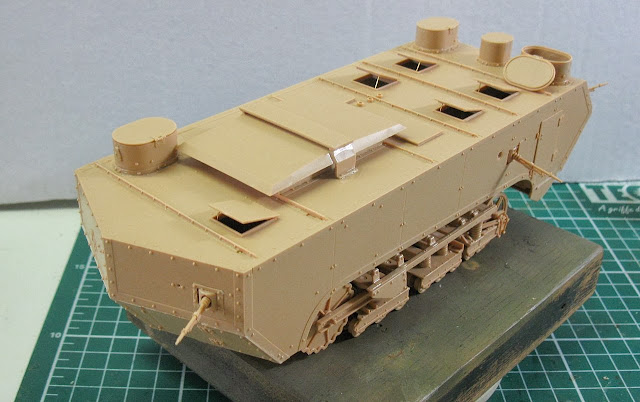Mon cher Poilus, enfin...
Vive la France !!!
After a long, long wait, here's something really interesting, mon amis ... Finally more options in vehicles from WWI. Today lets meet this monster: Char Saint Chamond (early) - World War One French heavy tank. Avant!!
 |
| char Saint Chamond - French heavy tank - early |
History:
The Saint-Chamond was the second French heavy tank of the First World War, with 400 manufactured from April 1917 to July 1918. Born of the commercial rivalry existing with the makers of the Schneider CA1 tank, the Saint-Chamond was an underpowered and fundamentally inadequate design.
_tank.jpg) |
| Schneider CA1 tank |
Its principal weakness was the "caterpillar" tracks. They were much too short in relation to the vehicle's length and heavy weight ( 23 tons ). Later models, however, attempted to rectify some of the tank's original flaws by installing wider and stronger track shoes, thicker frontal armor and the more effective 75mm Mle 1897 field gun. The Saint-Chamond tanks remained engaged in various actions until the late summer of 1918, belatedly becoming more effective since combat had moved out of the trenches and onto open ground. Eventually, however, the Saint-Chamond tanks were scheduled to be entirely replaced by imported British heavy tanks, such as the Marks IV.
 |
| British heavy tank Mk IV Male - |
Development of the french tanks
The Schneider:
In January 1915, the French arms manufacturer Schneider sent out its chief designer, Eugène Brillié, to investigate tracked tractors from the American Holt Company, at that time participating in a test programme in England. The original project was to equip a mechanical wire-cutting machines of the Breton-Pretot type. On his return Brillié, who had earlier been involved in designing armoured cars for Spain, convinced the company management to initiate studies on the development of a Tracteur blindé et armé (armoured and armed tractor), based on the Baby Holt chassis, two of which were ordered.
Experiments on the Holt caterpillar tracks started in May 1915 at the Schneider plant with a 75 hp wheel-steered model...
 |
| restored Holt 75 wheel-steered tractor |
... and the 45 hp all-caterpillar Baby Holt, showing the superiority of the latter. On 16 June, new experiments followed in front of the President of the French Republic, and on 10 September for Commander Ferrus, an officer who had been involved in the study (and ultimate abandonment) of the Levavasseur tank project in 1908.
In early 1916, the first prototype of the Schneider tank was assembled in an army workshop. It featured tracks from the American-made Holt caterpillar tractors that were already used in France for towing heavy artillery. Private Pierre Lescure designed the fighting compartment. Lieutenant Fouché lengthened the tracks to improve trench-crossing ability. In this early form the prototype of the Schneider was called Tracteur A - not for security reasons, but because nobody knew exactly how to call such vehicles; the French word char was not yet applied to tanks. However, Eugène Brillié, the chief designer at Schneider, rejected this Tracteur A prototype. Instead he had invented a tail for his own tank's chassis thus providing the same trench crossing ability but for less overall weight and length.
The Saint-Chamond:
While Brillié began to assemble this second prototype which was to become the Schneider CA1, the arms manufacturer Forges et Aciéries de la Marine et d'Homécourt aka "FAMH", based at Saint-Chamond, Loire, was given an order for 400 tanks by the French government. They intended to build a tank similar to the Schneider. However, Brillié refused to share his patent for free, and Saint-Chamond refused to pay. As a result the "Forges et Acieries de la Marine et d'Homecourt" company, being unable to replicate certain patented details of the new Schneider tank, developed its own proprietary design: the "Char Saint-Chamond". It did include a "Crochat-Colardeau" gasoline-electric transmission, an already proven system existing on railcars used for the French railways. Furthermore, the freedom to design a heavier and larger vehicle gave Saint-Chamond the opportunity to upstage the Schneider company. They did it by installing on their own "Char Saint-Chamond" a more powerful, full size 75mm field gun plus 4 Hotchkiss machine guns instead of the two machine guns present on the Schneider tank.
Saint-Chamond's technical director was Colonel Émile Rimailho, an artillery officer who had become dissatisfied over the insufficient reward he had received for helping design the famous Canon de 75 modele 1897 field gun as well as the Modele 1904 155 mm "Rimailho" howitzer.
 |
| "Rimailho" howitzer - model 1904 -155 mm |
Following his departure from the French State arsenal system (APX) and joining Saint-Chamond, Rimailho designed a 75 mm field gun similar to the Mle 1897 75 mm gun he had co-developed with Sainte-Claire Deville. It was the proprietary Canon de 75mm TR Saint-Chamond (Modele 1915), designed to fire the regular French 75mm ammunition. Colonel Rimailho, who had a direct financial interest in selling his company's gun, induced the Ministry of War to specify that the new Saint-Chamond tank would also mount the Saint-Chamond made 75. In so doing Rimailho had also upstaged the Schneider CA1 tank which could only be fitted with a smaller Schneider-made fortress gun firing a 75mm reduced charge ammunition. To accommodate a regular length and full size 75mm field gun, a longer hull than on the Schneider tank was essential. The Saint-Chamond prototype, a tracked vehicle longer and heavier than the Schneider tank was first demonstrated to the French military in February 1916.
 |
| Saint Chamond tank prototype |
When Colonel Jean Baptiste Eugène Estienne, who had taken the initiative to create the French tank arm, learned that an order for 400 additional Saint-Chamond tanks had been passed on April 8,1916, he was at first quite elated. When it later became apparent that they would be of a different type, Estienne was shocked and wrote: "I am painfully surprised that an order has been launched of this importance without asking the opinion of the only officer who, at the time, had undertaken a profound study of the technical and military aspects involved and who had brought the supreme commander to the decision to take this path [towards a tank arm]".
Description:
As a result of Rimailho's manipulations, the new tank had become a rather cumbersome and underpowered vehicle. It lacked a rotating turret, instead using a large overhanging front compartment housing the long 75 mm gun protruding from the nose. Within the forward fighting compartment and on the left was the driver, also the vehicle commander.
 |
| Saint Chamond commander/driver |
 |
| Inside Saint Chamond: Commander/driver (left), main gunner (center) and the loader/MG gunner (right) |
On the right a machine gunner operated the front Hotchkiss machine gun. This machine gunner was also responsible for the breech operation of the 75mm gun which he had to perform after pivoting on his seat to the left. A loader (referred to in some sources as the gunner) adjusted the gun's elevation, observing the target through a small hatch in the front of the tank, which left him vulnerable to enemy fire. Traversing the 75mm gun implied traversing the whole tank, and this was performed by the driver.
 |
| Front fighting compartment - right lateral MG gunner |
A second fighting compartment at the back held one machine gunner next to the secondary driver's position, where the tank could also be driven backwards by the mechanic in an emergency.
 |
| Lateral left MG gunner |
Between those two compartments stood in the open the gasoline engine and the electric generator. Narrow passageways on both sides of the engine connected the front and rear compartments. The passageways also held Hotchkiss positions, one on each side in front of the engine. Altogether, the Saint-Chamond had 4 Hotchkiss M1914 machine gun positions: one in the front, one in the back and one on each side of the tank.
 |
| Hotchkiss M1914 machine gun |
Despite weighing 23 tons, the tank could manage a top speed of 12 km/h. This speed was seldom achieved in the field as the long nose was prone to dig into the ground. The relatively high maximum speed on flat ground was made possible by the "Crochat Colardeau" transmission which coupled a Panhard-Levassor 4 cylinders 90HP sleeve-valve gasoline engine to an electric generator capable of giving an output of 260 amperes under 200 volts. The generator was connected to two separate electric motors, one for each track, thus permitting perfect gradual steering of the tank.
 |
| Saint Chamond engine: Panhard-Levassor (petrol) 4-cylinder - 90 hp |
Due to its short tracks and over-extended body, the vehicle experienced major difficulties in crossing trenches and overcoming obstacles.
 |
| Saint Chamond (late) negotiating with difficulty in a tricky terrain. Notice how the gun is exposed to injury |
This led to such negative reactions by the crews in training that a special mention was passed on to General Headquarters: Nobody wants to serve on the Saint-Chamond. Second Lieutenant de Gouyon, principal Saint-Chamond driving instructor at Marly, has publicly declared that it has become virtually impossible for him to continue to carry on and, since he is a Member of Parliament, that he will request to have the whole matter placed on the next parliamentary agenda.
Improved Saint-Chamond tanks (1918):
Originally the crew of nine men was protected by 11 mm of steel armour on the sloping front and 17mm on the sides. Later on, the addition of an extra layer of spaced 8.5 mm armour on the front improved protection.
 |
| Saint Chamond lateral front armour after impact. Notice the armour's construction |
Beginning with the 151st vehicle, the roof was also redesigned with a double slope so that satchel charges and grenades would slide off.
 |
| Saint Chamond early- flat roof and cylindrical observation turrets in the front |
Concurrently, the original observation turrets in front and rear were done away and replaced by slits:
 |
| Saint Chamond mid- sloped roof and no turrets. Notice the new main gun model 1897 in the nose of the tank |
 |
| Saint Chamond mid- in Invalides exhibition. Notice the new main gun model 1897 |
Later, a single low profile square turret was reintroduced in the left front corner of the tank, to enhance the front and sides vision by the tank's driver/commander.
 |
| Saint Chamond late - squared turret in front-left for commander and sloped roof |
With time, the tracks were also widened in two steps from 324 mm to 412 mm to lower their ground pressure. After Saint-Chamond tank No 210 the more effective Model 1897 field gun was installed instead of Rimailho's (profitable) 75mm Saint-Chamond gun. At about the same time barrel-like rollers were added underneath the front and rear of the tank to help crossing trenches. This improved version was later called, unofficially, theModèle 18. Production slowed down in March 1918, after at least 377 had been assmbled, and ceased completely in July 1918.
Initially, forty eight Saint-Chamond tanks were modified as supply and recovery vehicles that could tow the lighter Schneider tanks. Their first action as a fighting vehicle took place at Laffaux Mill on May 5, 1917. Sixteen Saint-Chamond tanks were engaged there, several of them getting stuck into some trenches, but only three were destroyed in combat. During the rest of the war, twelve groups in total were formed with Saint-Chamond tanks : Artillerie Spéciale No's 31-42. During the summer of 1918, since combat had left the trenches for the open fields, it was used to engage German field gun batteries (Nahkampfbatterien) at a distance with its 75mm cannon. The Saint-Chamond proved at last quite effective in this specialist assault gun role.
 |
| Saint Chamond late crossing a village, 1918. |
The Saint-Chamond's final engagement in battle, with initially 16 tanks, took place in early October 1918, in support of the U.S. First Division near Montfaucon. As reported in Ralph Jones et al. ( 1933 ) in reference to this last engagement :" The Saint Chamond tanks were handicapped by damage to their tracks, by derailments,, by the breakage of the caps of connecting rods on forward bogies and of track pins". However, by that time, the Renault FT tank had successfully taken over the major role in the French tank force and had also been purchased by the American Expeditionary Forces in France. After the war 54 were rebuilt as ammunition carriers; the remainder scrapped.
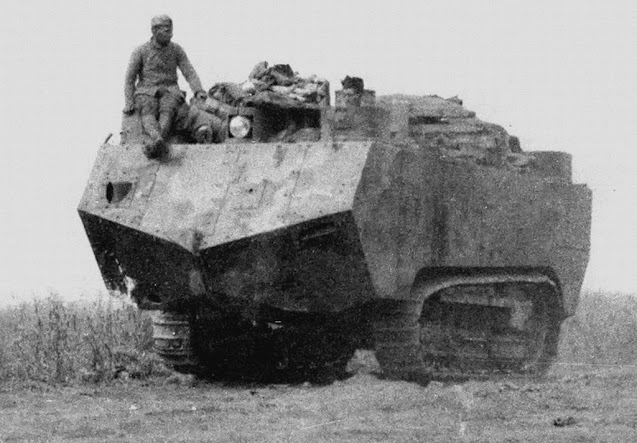 |
| Saint Chamond ammo carrier (early) - Notice the late tracks |
 |
| Saint Chamond ammo carrier (early) |
The last Saint-Chamond tank remaining in existence ( an improved mid-1918 model ), alongside other French tanks of World War I ( Schneider CA1 and Renault FT ), is preserved at the Musée des Blindés at Saumur, France. It had survived, together with a Schneider CA1 tank of the same vintage, at the Aberdeen Proving Grounds Ordnance Museum in Maryland, USA, and was later donated by the U.S. to the French government. Although very well preserved at the Musee des Blindes, this unique Saint-Chamond tank could not be fully restored to self mobility due to the irreversibly degraded conditions of the two electric motors and of the electric generator. The recently spray painted camouflage colors have been questioned as unrealistic and too bright as well as unlike those that were applied by hand at the time during World War I.
 |
| Saint Chamond late - the last of the kind in Saumur, with spurious colours... |
Specs:
| Saint-Chamond heavy tank - early | |
|---|---|
| Place of origin | France |
| Specifications | |
| Weight | 23 tonnes |
| Length | 8.9 m |
| Width | 2.7 m |
| Height | 2.4 m |
| Crew | 8 (commander-driver, gunner-loader, assistant gunner, 4x machine gunners, mechanic) |
| Armor | 11–19 mm |
Main armament | 75 mm gun |
Secondary armament | four 8 mm Hotchkiss M1914 machine guns |
| Engine | 4-cyl. PanhardLevassor petrol - 90 hp (70 kW) - Crochat-Colardeau electric transmission |
| Power/weight | 4 hp/tonne |
| Suspension | coil spring |
| Speed | 12 km/h |
The kit:
The kit from Takon (#2002) as awesome, with a beautiful box art. Very good injection, with LBL tracks and a good decal.
 |
| Saint Chamond heavy tank - Takom (#2002) box art |
No PE or metal barrels in the kit (why??). A very good booklet with detailed instructions. The kit also comes with a figure (Commander?) with a face armour.
 |
| French tankers with face armour |
The hell is that the figure is pointing.. (I hate it ... why manufacturers love making figures pointing?)
Well, let's have some fun...By the book, starting by the turrets. The kit is the early version, with flat roof and turrets...
 |
| Starting by the turrets... |
 |
| The upper hull with turrets... WWI style !!! |
 |
| The exhaust and muffler is in dry-run. Better for paint... |
 |
| Adding claws to my beast. The main gun and MGs...Sadly, no metal barrels here .... |
 |
| The building is easy and swift...a true delight !!! |
 |
| Starting the chassi... |
 |
| Growing...growing... |
Some advances today...Starting the suspension frame...be careful, because the parts are very fragile...
 |
| The suspension inferior frame....and wheels...many wheels... Be sure to retain the sprocket wheels turning |
A tip: Build all the suspension in a same time or step. Don't stop to eat or go in the toalette...It's very important !!!! Use welders or liquid glue to build the parts. Minimum movements are required for the perfect alignment between parts and sub-parts......
Another VERY IMPORTANT TIP: When you build your beast, be sure to retain the sprocket wheels turning ... The other wheels in the suspensions can all be glued (I did them so ...) but if sprocket is glued, you will not be able to enter the track, later!!!
 |
| The frame ready...Man...the worst part of this incredible and delicious kit.... |
 |
| Gluing the frame into the chassi...The thing fits perfectly ... The kit is fantastic!! |
As I said before: Keep the alignment!!!
 |
| Uops...wrong picture !!!! |
 |
| Perfect alignment!! |
 |
| Dry-run... |
 |
| Size comparison... |
The Saint Chamonds wore a huge headlight in a central turret. The headlight is typically from rail origin. And I had an old (but very old) lens from MVLenses, deep in my shelf .... it's time to use it!!
 |
| In nature (and scale modeling...) nothing is lost, everything is transformed ... |
 |
| Voilááá.. The yellowish appearance is so WWI fashion!! |
 |
| I made supports for the headlamp and the loader/gunner |
 |
| And the hull glued in the chassi.... |
 |
| Notice the holders of hatches, which I made with PE scraps |
Painting:
 |
| Primer Vallejo white plus a mix (50% +50%) Vallejos grays. |
 |
| Surgery in the gunner... |
 |
| Testing the crew in the tank.... |
 |
| Magnifique !!! |
 |
| Colors... |
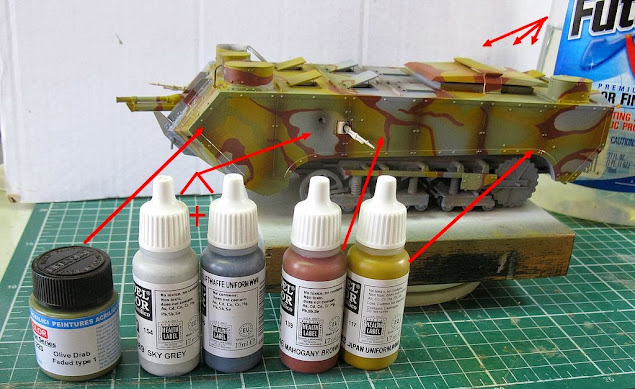 |
| The recipe: Lifecolor + Vallejos....Future to prevent silvering... |
 |
| The Future will sleep for the decals, tomorrow !!!! |
Now, the worst step: tracks link-by-link....I hate this !!!! These tracks in particular are disgusting to build. First of all, remove the parts from sprues and clean-up the little parts. Building one complete set first, as a reference and guide. The shoes you can glue in the links, after ...
 |
| The parts: links with pins (male links) , female links and shoes... |
The sequence is:
1- Take a male link (with pin) and in his pin, insert another male link and a female link.
2- drop a minimum portion of glue in the pin of male link and close the link with female link.
3- be sure that the link remains moveable...
 |
| First step of the track building... |
4- Glue the shoe in the first link...
 |
| With shoe... |
5- Continue to assemble the links ...
 |
| Adding links... |
 |
| Links waiting shoes... |
6- After assembling a half dozen links, glue the shoes ...
 |
| With shoes.... |
7- a tip: Building the tracks in a long run... Do not take too long time to adapt the tracks in the suspensions because some adjustments are always necessary ...Don't use super-glue or cyanoacrilate...
 |
| The tools for the tracks... |
8- Build 2 tracks with 36 links and glue 35 shoes. The last shoe will glued in track, after the last link fit in the place...
9- Painting...
10- Done !!!
 |
| Voilaááá´... |
 |
| The gunner, after surgery, , being prepared for painting. |
I finished the st. Chamond project ...I did quite dirty vehicle, because the pictures we have available these tanks on the battlefields attest to this ability to get dirty ....
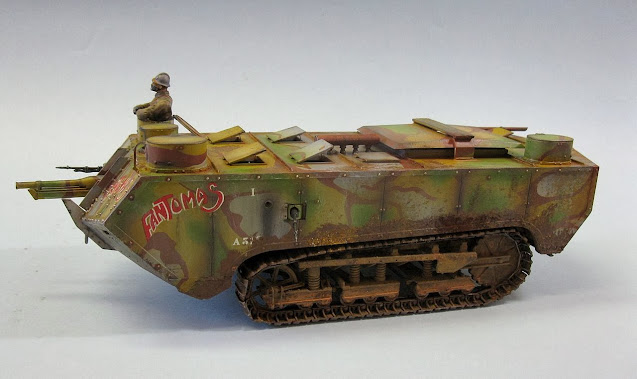 |
| Heavy tank Saint Chamond FANTOMAS (early) Artillerie Spéciale 31 (As31) - France, 1917. |
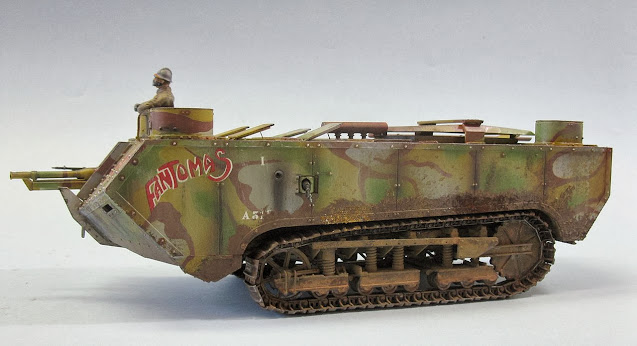 |
| saint Chamond FANTOMAS (early) - left side |
 |
| Heavy tank Saint Chamond FANTOMAS (early) Artillerie Spéciale 31 (As31) - France, 1917. |
 |
| saint Chamond FANTOMAS (early) - right side. |
 |
| saint Chamond FANTOMAS (early) - rear view. |
 |
| Heavy tank Saint Chamond FANTOMAS (early) Artillerie Spéciale 31 (As31) - France, 1917. |
 |
| saint Chamond FANTOMAS (early) with Kojak, for size comparison |
 |
| The bald one very pleased... |
And now, an interesting comparison of proportions: The Saint Chamond with Sherman. The French girl is huge !!!!
 |
| Two famous girls, side by side... |
Well, Gents. The Takom's kit is very, very good to fit and build...easy, swift and the instructions are clear and detailed. The tracks are difficult, but nothing we can call impossible ...I recommend !!!
Au revoir pour le moment ...








